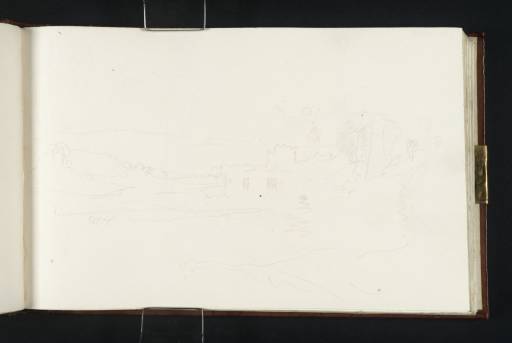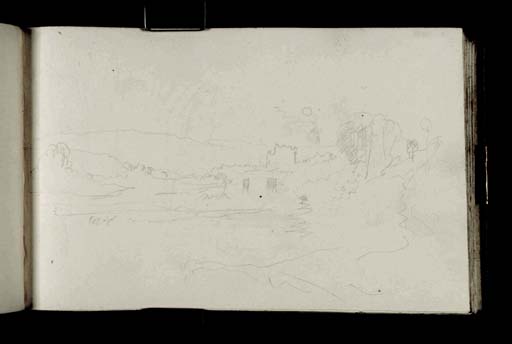Joseph Mallord William Turner Bywell Castle and the Ruined Tyne Bridge towards Sunset 1817
Image 1 of 2
Joseph Mallord William Turner,
Bywell Castle and the Ruined Tyne Bridge towards Sunset
1817
Joseph Mallord William Turner 1775–1851
Folio 81 Verso:
Bywell Castle and the Ruined Tyne Bridge towards Sunset 1817
D12424
Turner Bequest CLVII 81a
Turner Bequest CLVII 81a
Pencil on white wove paper, 116 x 185 mm
Inscribed by Turner in pencil ‘Dark’ at centre
Inscribed by Turner in pencil ‘Dark’ at centre
Accepted by the nation as part of the Turner Bequest 1856
References
1909
A.J. Finberg, A Complete Inventory of the Drawings of the Turner Bequest, London 1909, vol.I, p.450, CLVII 81a, as ‘River scene’.
Turner’s vantage point is the road to Ovingham, looking south-west up the River Tyne beyond the ruined bridge piers to Bywell Castle. It stands beside the north bank of the Tyne on the north-eastern edge of the village, about half way between Newcastle and Hexham, and a few miles upstream from Prudhoe Castle, the subject of various adjacent drawings in this sketchbook (see the entry for folio 78 recto, D12417).
The gatehouse-keep dates from the early fifteenth century and was built for the Nevill(e) family, who also owned Raby Castle, one of Turner’s prime motivations for his 1817 visit to the area (see the introduction to the tour). It was long ruined by the time Turner saw it and is now a roofless shell.1
The bridge east of the village (along with almost all the others in the Tyne Valley) had been destroyed in the ‘Great Flood’ of 17 November 1771, an immensely destructive event which may have been the most serious of its kind in Britain; there had been another major flood in 1815.2 A contemporary account of the two stone piers which survived suggests that its superstructure had been wooden, as ‘there appears no spring of arches’ and it may have been built ‘merely to lead to the chapel’3 which once stood on the south bank a little west of the present bridge.4 The piers may even have dated from Roman times, but they were blown up when a new bridge was constructed in 1836.5
There seems to be some indication of the shallow rapids on the near side of the bridge. The disk above the castle is presumably the setting autumnal sun, with a long reflection indicated in the water below. There is a similar view from a little closer to the castle on folio 82 verso (D12426). A series of studies at Bywell runs between the present page and folio 88 verso (D12438).
With its fortuitously Picturesque combination of a ruined building and bridge, Bywell would seem to have caught Turner’s attention as a variation on the Claude Lorrain-style ‘Elevated Pastoral’ subjects he had devised for his Liber Studiorum prints, such as the Woman and Tambourine of about 1806–7 (see Tate D08103; Turner Bequest CXVI B). However, he did not develop the subject, although other artists did produce idyllic finished views (see under folios 82 verso, 84 verso and 86 verso; D12426, D12430, D12434).
Matthew Imms
February 2010
‘Bywell Castle gatehouse (Bywell), Keys to the Past, accessed 26 January 2010, http://www.keystothepast.info/durhamcc/K2P.nsf/K2PDetail?readform&PRN=N10061 .
‘Tyne Catchment Flood Management Plan: Consultation Report – Scoping Phase’, Environment Agency, accessed 26 January 2010.
E. Mackenzie, An Historical, Topographical, and Descriptive Account of the County of Northumberland, 2nd ed., Newcastle upon Tyne 1825, vol.II, pp.351–2.
‘St Helen’s Chapel (Broomley and Stocksfield)’, Keys to the Past, accessed 26 January 2010, http://www.keystothepast.info/durhamcc/K2P.nsf/K2PDetail?readform&PRN=N10129 .
‘Bywell Bridge’, Bridges on the Tyne, accessed 26 January 2010, http://www.bridgesonthetyne.co.uk/bywell.html ; ‘Bridge (Bywell) ‘, Keys to the Past, accessed 26 January 2010, http://www.keystothepast.info/durhamcc/K2P.nsf/K2PDetail?readform&PRN=N10131 ; ‘Bywell Bridge (Broomley and Stocksfield; Bywell), Keys to the Past, accessed 26 January 2010, http://www.keystothepast.info/durhamcc/K2P.nsf/K2PDetail?readform&PRN=N10152 .
How to cite
Matthew Imms, ‘Bywell Castle and the Ruined Tyne Bridge towards Sunset 1817 by Joseph Mallord William Turner’, catalogue entry, February 2010, in David Blayney Brown (ed.), J.M.W. Turner: Sketchbooks, Drawings and Watercolours, Tate Research Publication, December 2012, https://www


